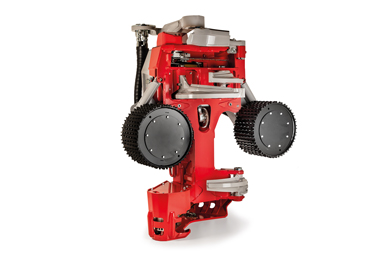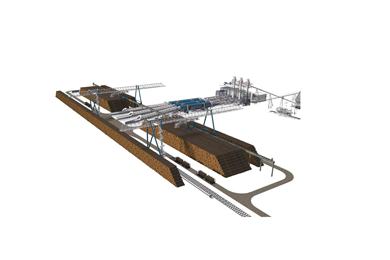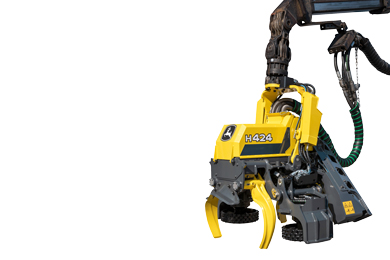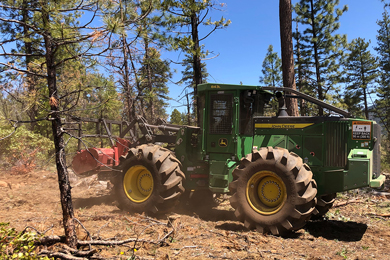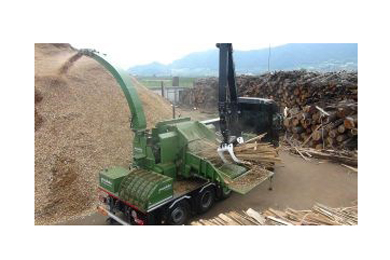At the last 2020 Oregon Logging Conference, Log Max presented to the public the next generation 7000XT Top Saw
This pre-series was due for testing under 2020 before a release later this year, there has been some delay due to covid-19 situation yet there is hope for the series production to start at the beginning of 2021.
The new log max 7000XT is a durable, easy-to-work, accurate, and intelligent workmate, ready for the toughest applications.
Weighing 2 270 kg (5,004 lbs) it has everything you would expect from a modern harvesting head and is designed to withstand the toughest applications no matter how or where in the world you use it. It offers accurate and precise length and diameter measuring and has many smartly designed features that greatly simplify service.
What makes the 2020 7000XT Top Saw special :
– Durability : the frame is reinforced in many places to withstand the toughest jobs and increase lifespan.
– Cutting performance, the 7000XT Top Saw as new saw valves for both units that have been optimized to offer fast, trouble-free cutting.
– The measuring results, there is a high requirement for today’s harvester heads to deliver precise measurement results. The 7000XT measuring unit has been redesigned to meet these requirements.
– Simplicity & ease of access : It’s now even easier to perform regular maintenance and service on the head thanks to Improved accessibility, well laid out hoses and grease nipples makes life easier.
Strength and durability
To improve the frame’s durability and life span, the attachments for all the delimbing knives and for the feed roller arms have been strengthened. The lower knife has a new reinforced mechanical stop in both open and closed positions. In the open position, the inside of the frame has been strengthened, inside the oil tank. In the closed position, a mechanical stop has been integrated in the frame. To increase the lower knifes lifting capacity and improve the stem holding, the cylinder for the lower knife has been upgraded. Both the lower knife attachment and the knife itself are updated to work optimally with the new larger cylinder.
The frame´s design around the measuring wheel hole has been modified and the stoppers for the roller arms on the inside of the frame reinforced. A replaceable wear plate has been added on the frontside of the Top Saw box. Instead of wearing down the centerline of the frame, the new wear plate will take the hit.
The 7000XT Top Saw will, from now on, be equipped with a hydraulic top knife as standard. This feature allows the upper knife to automatically retract when the head feeds backward, a good way to protect the knife from damage. The 7000XT has new reinforced knives with welded knives edges. The knife-edge has an increased thickness and is interchangeable. The tip of the knifes have a smaller round tip, which makes them function more like a tweezer, making it easier to pick stems from a woodpile. The knives are also better suited for hardwood thanks to a steeper angle of the lower part of the knife helping to fend away thicker branching. The lower knife is reinforced to adapt to the new, more powerful cylinder.
Cutting performance
The head comes equipped with the 611 has the main saw and the 318 for the top saw. The saw 611 has a 60cc (3.66 cu.in) motor, manual chain tensioning and 3/4” chain, the top saw is the 318 with a 30cc (1.83 cu.in) motor and automatic tensioning.
To increase the performance and durability of the top saw, a new valve has been added. It has also been given a new position on the frame to simplify service and settings. The main saw also has a new valve that provides increased durability and better controllability of the saw. The valve has a new placement, directly mounted on the motor outlet, which minimizes the risk of cavitation. To improve cutting, the position of the main saw has been optimized. This modified geometry provides a faster cutting cycle and minimizes the risk of the wood splitting during cutting. This change in design of the saw box also provides extra room for the new, more powerful, saw cylinder.
Improved length measurement function & New contactless sensor
To offer the best measurement results, the length measurement function has been totally rethought. The design of the measure wheel cylinder, the hydraulic circuit have been improved and the measuring wheel arm and its attachment reinforced. The new measuring wheel unit includes a larger diameter measuring wheel. Altogether, the changes will allow the measuring wheel to follow the contour of the stem even better and provide the best measurement results. The new length measuring sensor is now contactless meaning that there are no mechanical moving components that will result in minimal or even service and maintenance free sensor. The spring-loaded sensor is placed in the arm and retained by a lock ring. An o-ring prevents it from turning, a magnet is fixed to the cover which is part of the wheel assembly. The measuring wheel assembly has also been equipped with a new bearing with tapered rollers which provides a more stable and stronger construction. To simplify the maintenance of the roller bearing, a lubrication point on the aluminium cover of the measuring unit has been added.
The heads come with many more improvements, such as the new laser find end sensor, the integrated safety pin attachment, hose protections that protects the base machine hoses from sticks coming from the front.


